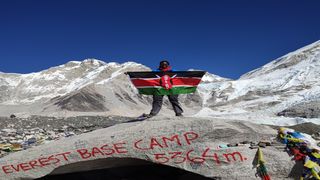
Kiprono Leting holds the Kenyan flag on Mount Everest.
| Courtesy | Kiprono LetingNews
Premium
Kenyan hiker has a taste of Mt Everest, wants more
What you need to know:
- Kiprono began hiking after meeting Sibusiso Vilane — the first African to summit Mount Everest.
For many typical Kenyans, hobbies may include bingeing on TV shows, playing a musical instrument, swimming or reading a book; for Kiprono Leting, however, his main pastime is hiking mountains and beating all odds to reach the summit.
Born and bred in Nairobi, Kiprono began hiking in 2012 after meeting South African mountaineer Sibusiso Vilane — the first African to summit Mount Everest.
“That was right after finishing university. The privilege of meeting Vilane, and hearing his story, inspired me to start hiking,” the 33-year-old tells the Nation.
In total, Kiprono has done 113 hikes since January 2013; a mix of mountains, hills and nature trails. His most notable have been Mt Kilimanjaro — which he has summited three times, Mt Kenya’s Lenana Peak (summited seven times), Mt Meru, Mt Elgon, and the icing on the cake, Mt Everest’s Base Camp.
“A hike is basically a walk. The most important bit of each major hike is the preparation.
“Normally, I advise people interested in hiking to start by taking long walks; exercising is important, but hiking is also mental, so when the mindset is right, you can hike any mountain,” Kiprono explains.

Kiprono Leting on Mount Everest.
Hiking did not come easy. At various times during his hikes he thought of quitting and even questioned whether hiking, with all the strain that goes into it, was worth the trouble.
“My second major hike was Mt Kilimanjaro, and I didn’t summit because I didn’t prepare well. I got really sick at Gilman’s point and I couldn’t move forward. I was frustrated for not summiting and I quit hiking because I was convinced I had had enough,” says the hiking blogger.
It wasn’t long before the entrepreneur threw himself back into hiking. In 2015, two years after quitting, Kiprono decided to revisit his old foe, this time with the aim of reaching the summit.
“I wasn’t done with Mt Kilimanjaro, and so, after preparing well, I revisited the hike and managed to summit. It was then that I was inspired to start my hiking blog, so that I could share the journey with Kenyans,” Kiprono says.
In 2020, when the pandemic hit, Kiprono’s hiking was stifled. He was limited to long walks at Karura and short hikes on the Ngong Hills; and yet even with the pandemic, he didn’t stop planning and preparing for future hikes in case the opportunity arose.
“I am part of a team called Kipepeo, we are six of us and we met on the hiking trails and seem to have a common interest of suffering on the trails. The challenges are not easy,” he says.
The team hiked Mt Kilimanjaro together, from base to summit and back to base in under 30 hours. They have also hiked Mt Kenya, base to summit and back in under 15 hours; and Elephant Hill, on the Aberdare Ranges, twice on the same day.
“Team Kipepeo, together with my blog, have kept me accountable and motivated me to keep hiking even on those days that I feel like quitting,” he says, “one of the most recurring questions has been why I chose hiking and the answer is simply -- the satisfaction that comes with summiting a mountain is unlike any other. You feel like a conqueror, suddenly all other problems feel small.”
Kiprono admits that hiking has enabled him to tackle his challenges with ease. Juxtaposing real life situations with hiking a major mountain has enabled him find solutions and develop a much higher adversity quotient than most of his peers.
And with every summit he conquers, Kiprono aims for another, and it wasn’t long before Mt Everest was added to his to-do list.
“Mt Everest is every hiker’s dream, but the thought of hiking it can be scary, especially considering the preparation needed in order to be fit to hike,” he explains.

Everest Base Camp is seen from Crampon Point, the entrance into the Khumbu icefall below Mount Everest.
The idea of hiking Mt Everest has always been at the back of Kiprono’s mind, but it wasn’t until Nepal opened its borders and lessened Covid-19 restrictions that he decided to do the base camp trek.
The base camp on Mt Everest, which is higher than Mt Kenya’s Lenana Peak, is probably the most accessible point for many hikers. Lenana Peak stands at 4,985m, while the Everest Base Camp is 5,364m high.
“Preparing for Everest meant hiking every weekend, but hiking Kilimanjaro was much harder than Everest’s Base Camp, majorly because Kilimanjaro’s summit is higher, but more than that, the base camp trek is set up such that you hike slowly and gain elevation gradually. Hiking Everest’s base camp takes 10 days while Kilimanjaro’s summit takes seven days, yet the latter is higher,” Kiprono explains.
For those who want to take up hiking, it is affordable, and rates only increase depending on the risk involved in hiking a particular mountain, however, the prolific hiker has a word of advice -- start small, and most importantly, prepare mentally before any hike.
“It is also advisable to have the essentials -- a good pair of boots, a rain coat, a head torch and a power bank, in case you get lost and you need to reach someone,” he says.
Kiprono is focused on climbing higher. He is definitely heading back to Mt Everest, this time going beyond the base camp. For now, Uganda seems to be on his list of future escapades.





